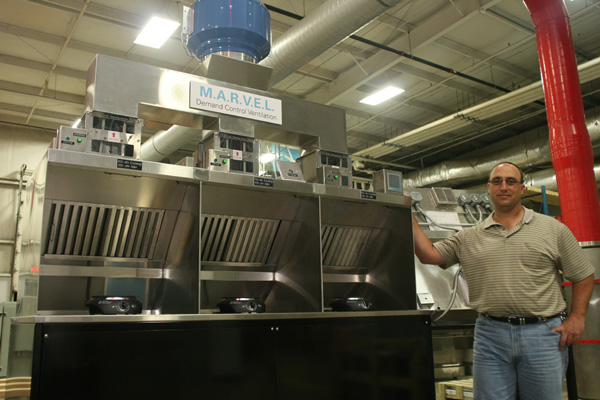
14 May Restaurant Industry to Marvel at Halton Innovation
May 14, 2009 (Scottsville, KY) [From The Citizens-Times]
Working in the kitchen area of a busy restaurant can be very fast-paced, hot work; it can also be a health hazard, due to grease particulates and other contaminants in the air.
Enter The Halton Group, which specializes in designing, testing and manufacturing high-tech, restaurant-capacity overhead ventilation and filtration systems. Halton’s reputation as a leader in restaurant air systems is well-known, with much of its research and development being done in specialized simulation laboratories at its Scottsville plant on Old Gallatin Road.
However, for about a year now, Halton has been cooking upsomething special, adding state-of-the-art electronic components from Dallas-based Current Energy, a recipient of the Department of Energy’s Energy Innovator Award. The joint effort has dished up the National Restaurant Federation Association’s Kitchen Innovations® Award. Restaurant and hotel industry representatives will be feasting their eyes on it in the 2009 National Restaurant Association’s Hotel-Motel Show, to be held this May 16-19 in Chicago.
Most major restaurants and chains have multiple cooking stations, for many different foods and cooking styles. The challenge for an efficient ventilation system is to provide adequate air flow and filtration to each station, while not using too much energy to be cost-efficient.
Halton and Current officials say the now patented M.A.R.V.E.L. (Model-based Automated Regulation of Ventilation Exhaust Levels) system is among the industry’s first “smart” systems. Utilizing a series of sensors and dampers that respond to the needs of each individual cooking surface, the M.A.R.V.E.L. system automatically adjusts the airflow as needed. It even senses when the cooking is done, and cycles the system’s energy use accordingly.
“It’s a wonderful product,” said Halton Group America Chief Technology Officer Andrey Livchak. “With today’s sensitivity not only toward managing energy costs but also to conserve natural resources, we are pleased to offer an innovative solution with Current energy. Together, we have created a one-of-a-kind product for food service facilities that is already tremendously cutting energy costs for notable kitchens around the country.”
“The M.A.R.V.E.L. system maintains indoor air quality and temperature comfort at minimum energy consumption, allowing restaurant owners to see consistent savings on energy costs and focus efforts on more profitable operations,” adds Current senior partner Joseph Harberg.
Halton Group has 21 facilities worldwide, but the Scottsville plant is its main research and design location. After opening in Scottsville in 1997, Halton has expanded its floor space four times to a current 83,000 square feet. Having started with only about 30 workers, the plant now employs 140. Most of M.A.R.V.E.L.’s design, research and manufacturing processes have been done in Scottsville, with some work having been done in a Canadian location.
Halton Vice President of Operations Phil Meredith noted that the system could mean energy use reduction of as much as 50 percent over conventional systems.
“A char-broiler needs more air flow than a griddle,” Meredith noted as an example. “If you only had one fan with a damper, it would pull a lot of air out of the center, but not as much on the ends. In this, the dampers keep the balance.”
Installed overhead just like a residential range hood, the Halton hoods can be made in lengths from five feet to 100 feet, depending on a restaurant’s kitchen layout, Meredith said. The system uses one to four units of Current’s IRIS (Infrared Radiation Index Sensor, patent pending) and the MC8 Current Energy Controller. The sensors read cooking station temperatures and adjust the dampers accordingly to control flow in the main exhaust duct. This allows the system’s single fan to be run at minimal speed to save energy.
M.A.R.V.E.L. also monitors its own maintenance. For example, if a filter has not been installed in one port, an alarm light will let its operators know as part of the startup process. If the fan is at 100-percent capacity but still is not maintaining adequate airflow, the system lets it operators know—a filter may be clogged or need a change.
M.A.R.V.E.L. can function as a stand-alone system, but is also designed to be integrated into a larger system if the restaurant so chooses. Through Current’s Energy Building Solutions Division, M.A.R.V.E.L.’s capabilities can be expanded to monitor of salad bar and soft drink machine temperatures or even ice dispensers needing a refill.
Meredith said Halton has fielded a lot of inquiries regarding M.A.R.V.E.L., and has been shipping custom-made systems for about seven months now.
“We anticipate that this will be one of our biggest items,” Meredith said, adding that the system really delivers the airflow, filtration and energy efficiency Halton wants to offer its customers. “It’s the logic built in that makes it so effective—using one fan, but capable of handling variable loads. We tried to make something no one else offers now.”
